Introducing HiveMQ Edge
Today HiveMQ introduced HiveMQ Edge, an open-source software gateway with an edge-optimized MQTT broker that integrates diverse endpoints to help streamline your operations. It standardizes edge data, supports a broad set of IT/OT connections, and provides a scalable, flexible way to channel data into your core infrastructure.
Many industrial organizations encounter difficulties when undertaking digital transformation initiatives aimed at improving their operations through the integration of OT data with IT-based analytics platforms. These include legacy connectivity interfaces prevalent in industrial devices, unique data representations in the device applications, and non-scalable point-to-point data integration patterns.
HiveMQ Edge simplifies this process. It allows you to easily collect data from industrial devices using OT protocols like Modbus and OPC-UA, establish a common data format, and integrate the data from the different systems and applications through a highly scalable hub-and-spoke model. Moreover, HiveMQ Edge is built with the Unified Namespace at heart, allowing you to map data from various sources into a semantically structured and unified view of OT and IT that enables real-time data analysis.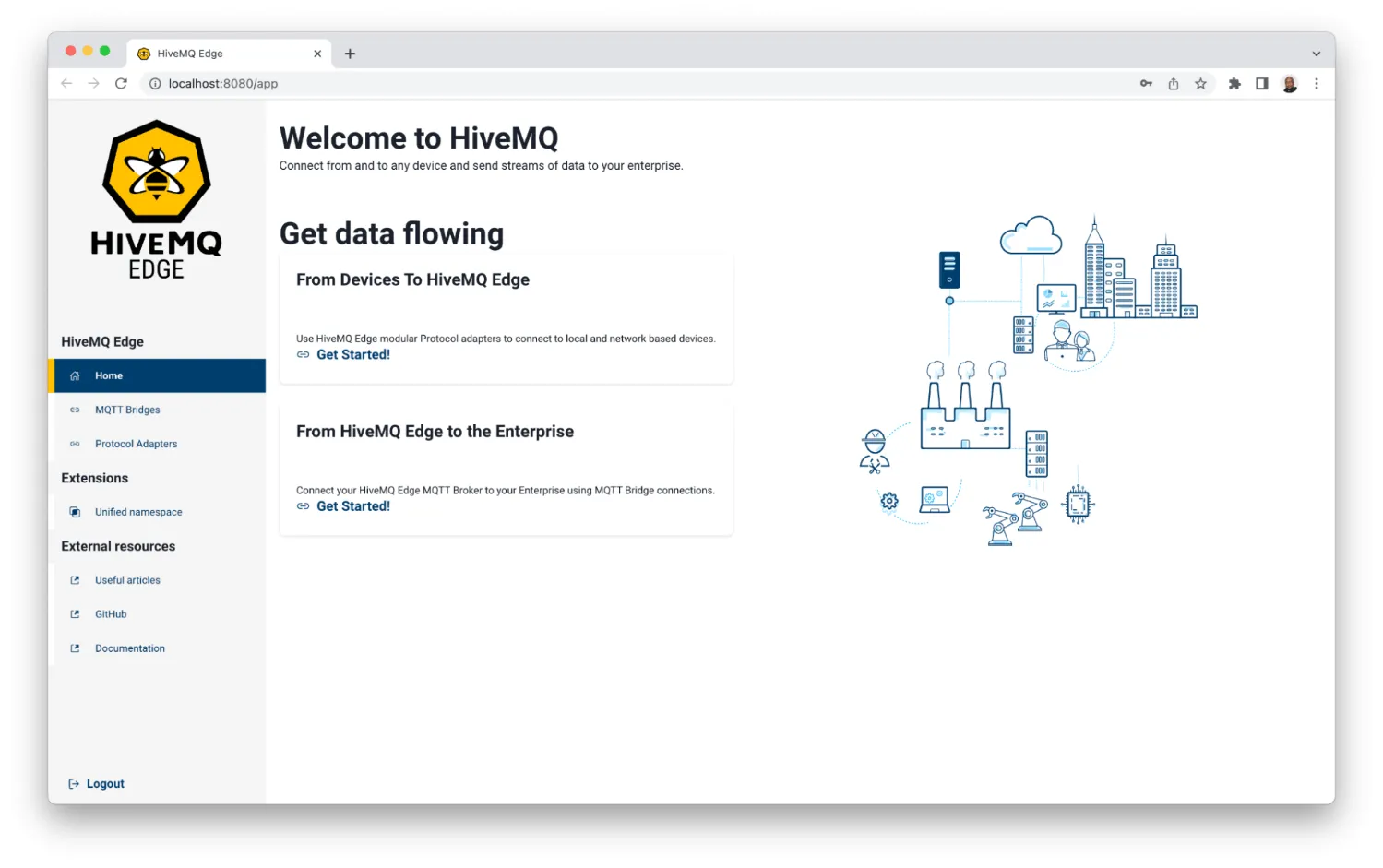
HiveMQ Edge Features and Benefits
HiveMQ Edge comes packed with features that make OT/IT integration easier than ever. Here are some of the key features that set HiveMQ Edge apart:
Edge-Optimized MQTT Broker: Includes a built-in MQTT broker that ensures messages continue to be processed at the factory floor with minimal disruption.
100% MQTT and MQTT-SN Compliant: HiveMQ Edge fully supports MQTT 3.x, 5 and MQTT-SN 1.2. This means that users can transport data to MQTT-based systems of their choosing.
Protocol Adapters: Modbus and OPC-UA adapters accelerate OT data integration with enterprise systems. More Protocol adapters will be added to the project over time.
MQTT Bridging: Bidirectional MQTT bridge functionality allows you to connect HiveMQ Edge to enterprise MQTT brokers, enabling you to build a UNS solution based on open standards.
Open Source and Rich SDK: HiveMQ Edge provides maximum flexibility to adapt the gateway to specific needs and benefit from a global community of experts.
Simplified UNS Implementation: Use transformers to help align information like timestamps and leverage ready-for-use UNS profiles based on ISA-95.
Intuitive UI and API-based Operability: Monitor and manage connections, bridges, and more through our intuitive interface or programmatically via APIs.
Integrate Data from Constrained Devices: Integrated MQTT-SN gateway allows low-power and limited bandwidth sensors to access the MQTT broker.
Cross-Platform Deployment: Although Linux is recommended, HiveMQ Edge runs on Windows, Linux and MacOS.
With its ability to facilitate experimentation and innovation at no extra expense, HiveMQ Edge can provide your business with a competitive advantage in the ever-changing industrial landscape. Check out the following guide to get started with HiveMQ Edge rapidly.
Demonstration: Integrating OPC-UA Data to HiveMQ Cloud Using HiveMQ Edge
While HiveMQ Edge seamlessly integrates with both the HiveMQ self-managed platform and HiveMQ Cloud, here we have outlined the process for setting up an IIoT data pipeline using HiveMQ Edge and HiveMQ Cloud. Our goal will be to gather data from a Programmable Logic Controller (PLC) with an OPC-UA interface and integrate it with a remotely hosted HiveMQ Cloud MQTT broker.
Begin by choosing ‘Protocol Adapters’ from the sidebar, which will present you with a list of all available adapters.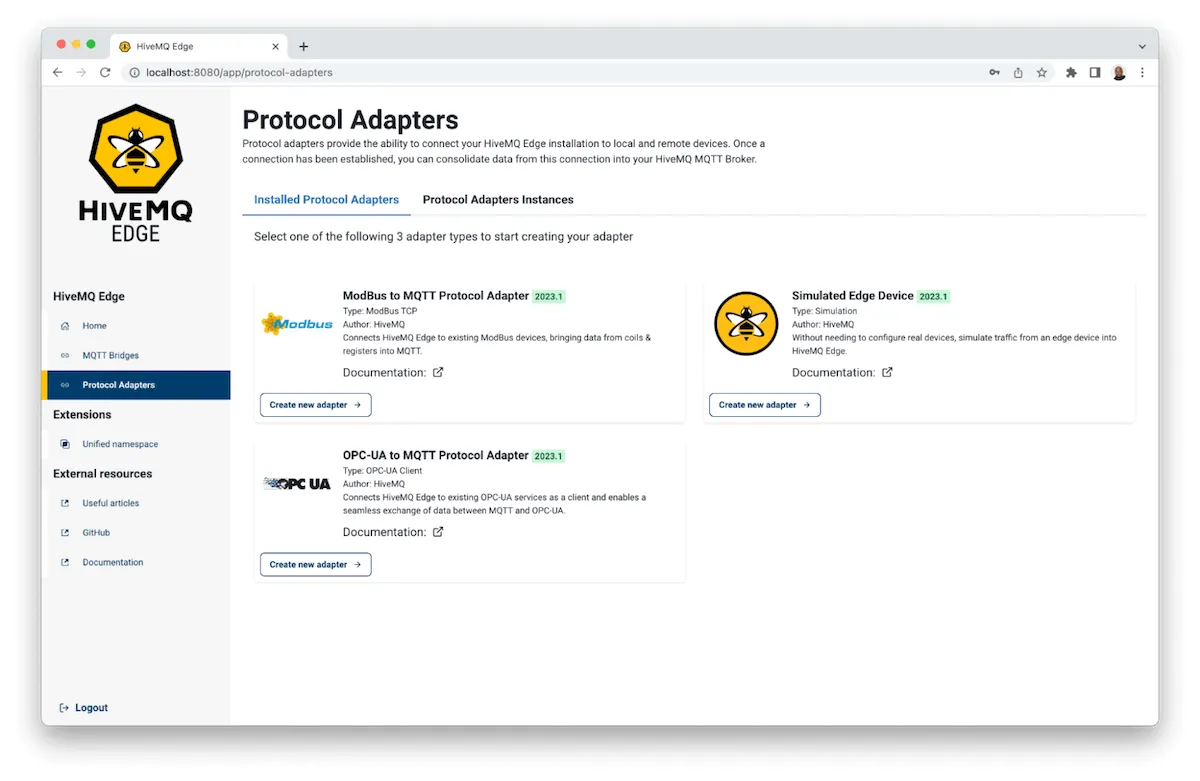
Proceed by selecting ‘Create new adapter’ under the OPC-UA to MQTT Protocol Adapter section.
Connecting HiveMQ Edge to OPC UA Data Source
Upon choosing to create a new OPC UA adapter, you will need to enter a unique identifier for your adapter instance and the endpoint URI of your PLC OPC UA server.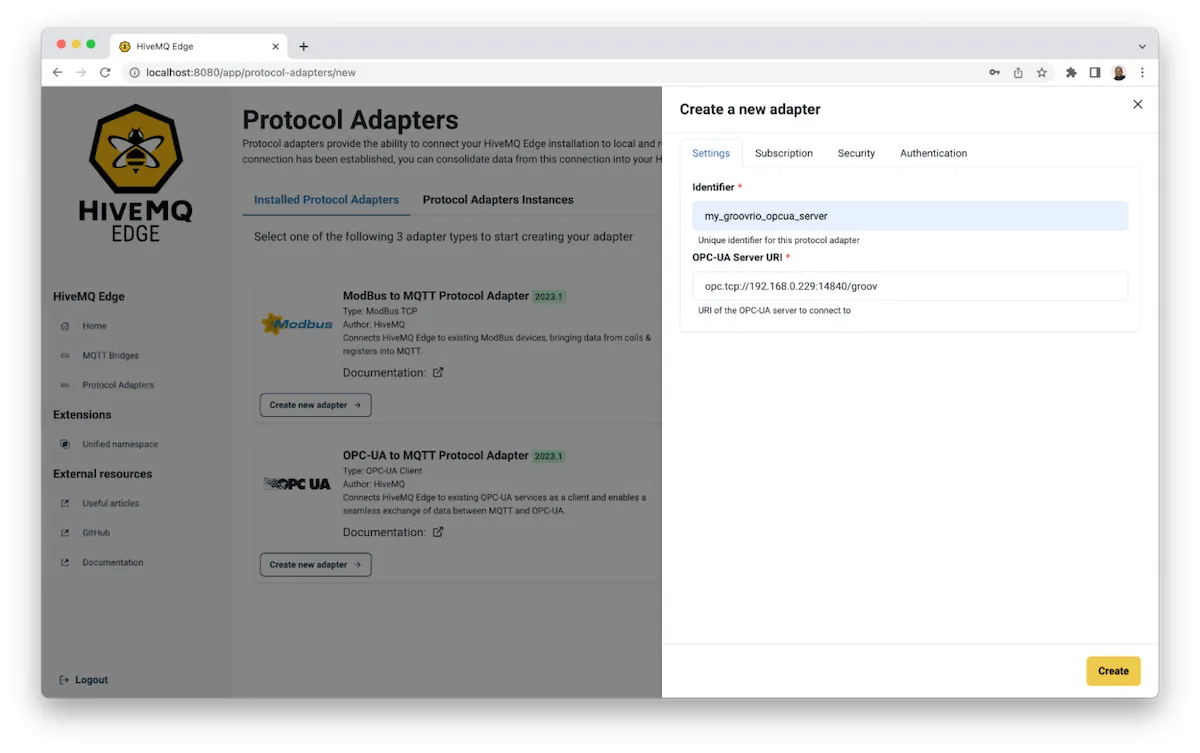
Navigate to the ‘Subscription’ tab. Here, provide the Source Node ID, which directs to the OPC UA variable that you wish to access from the PLC. In this scenario, we’ll be referring to the DischargePressure data point. Subsequently, specify the Destination MQTT Topic, i.e., the topic on the local HiveMQ Edge broker where you plan to publish the data extracted from your OPC-UA server.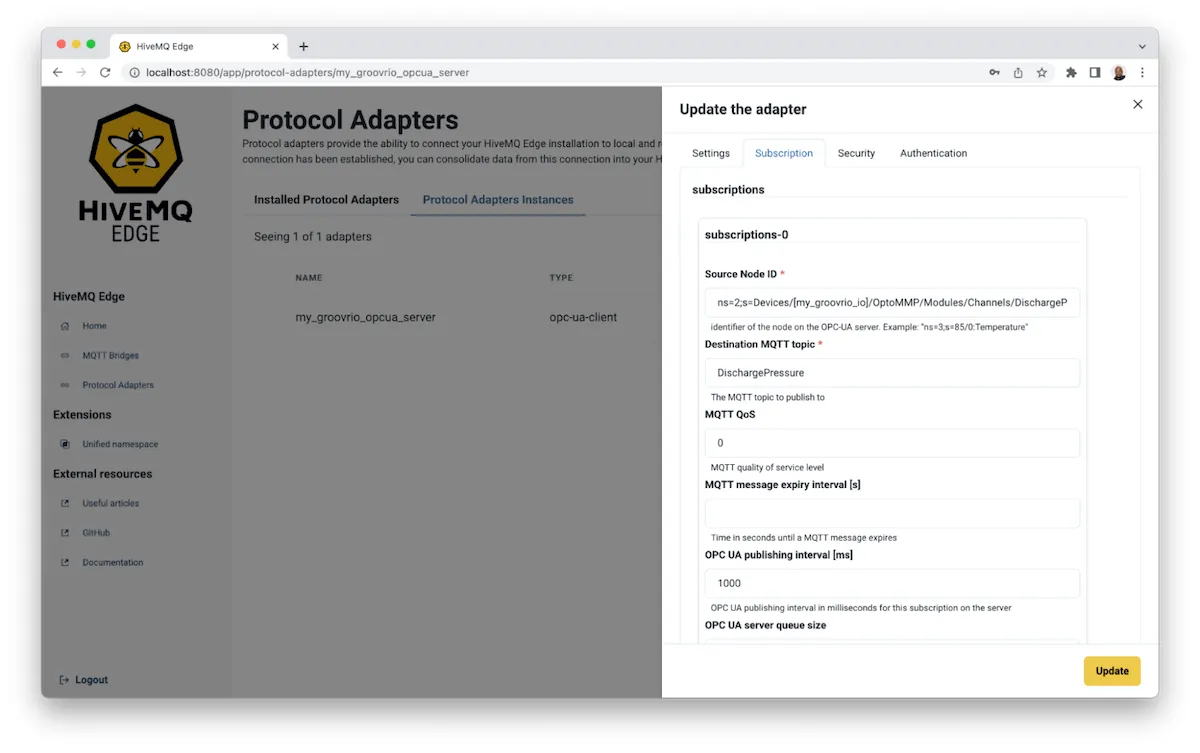
Under the ‘Security’ tab, enter your OPC-UA server’s security information. For this guide, the PLC has been set up to permit an anonymous server connection.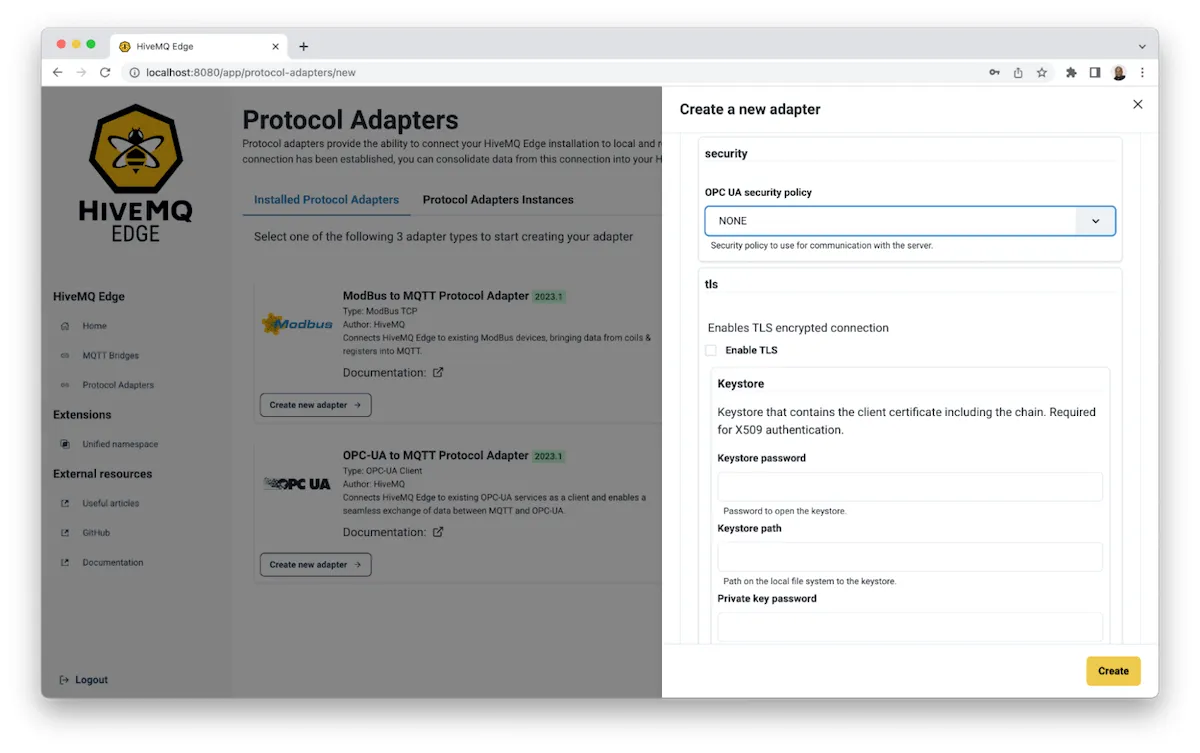
Following that, you will need to input your OPC-UA server’s authentication information.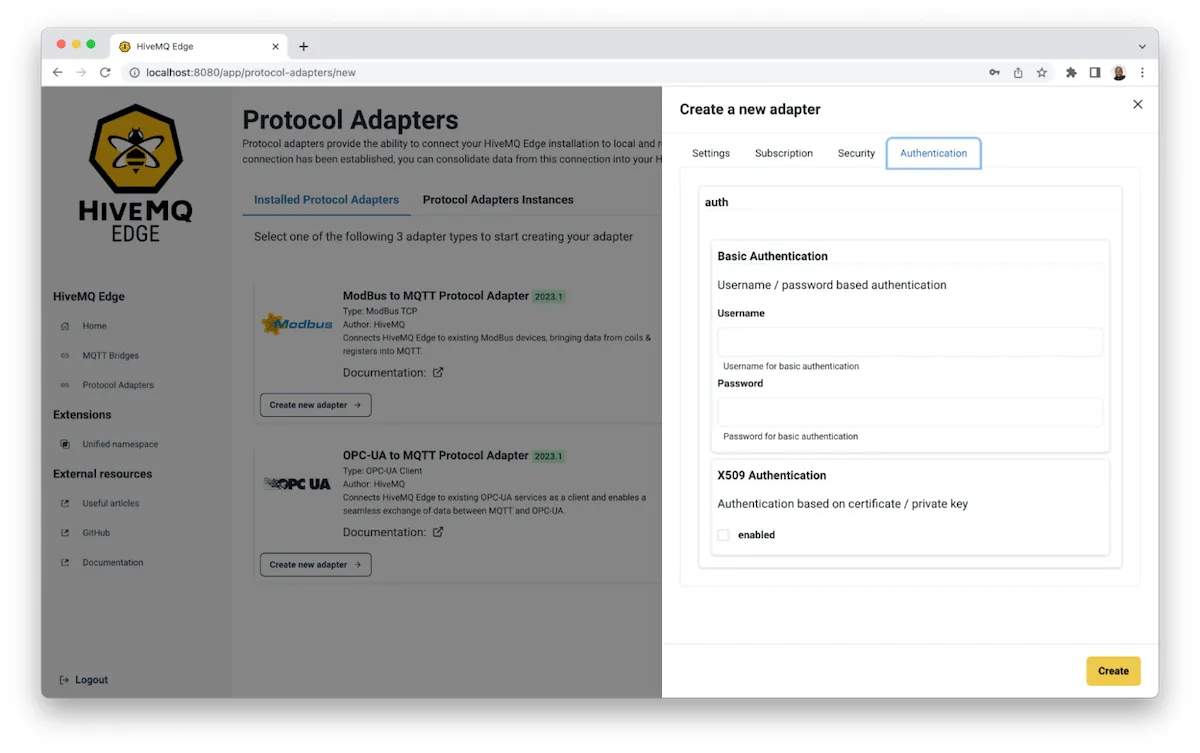
After providing all the necessary details, select ‘Create.’ A ‘Connected’ status should now appear next to your protocol adapter instance, indicating a successful setup.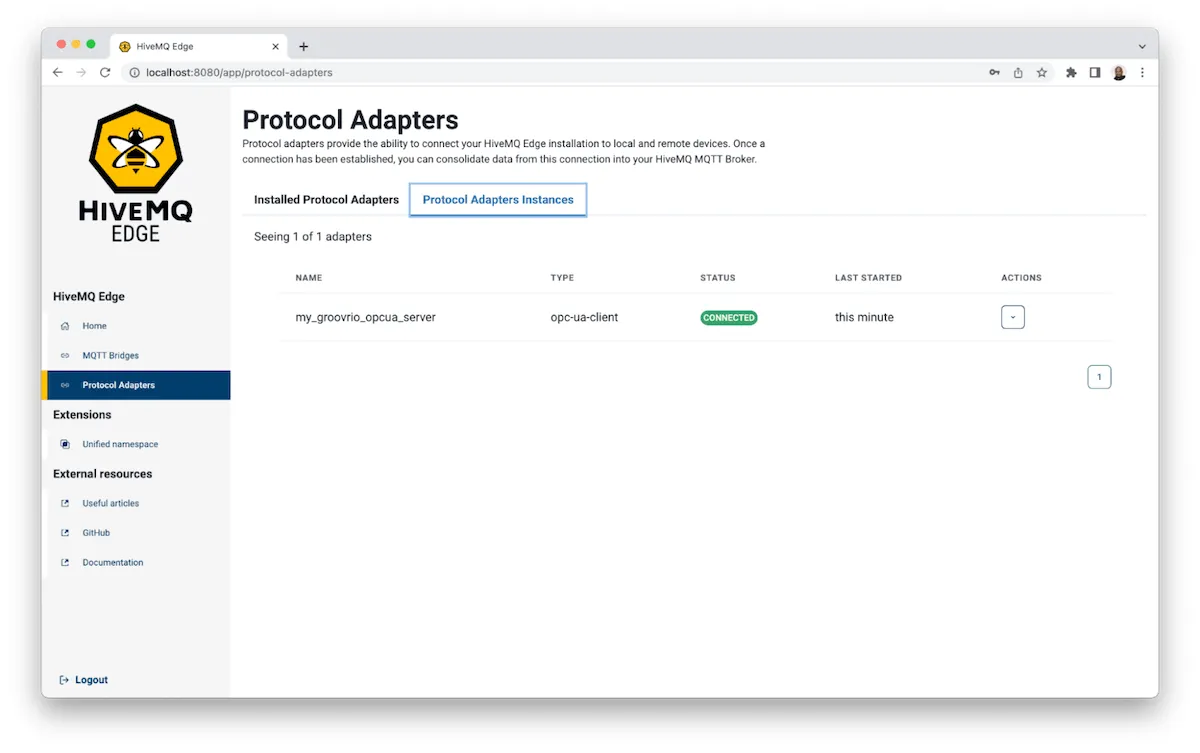
Connecting HiveMQ Edge to Cloud MQTT Broker
Once you’ve successfully connected to your OPC-UA server and started publishing data to the local MQTT broker, you can integrate it with a cloud-based MQTT broker utilizing the MQTT bridge functionality.
Choose ‘MQTT bridge’ from the side panel to view a list of all your configured MQTT bridges.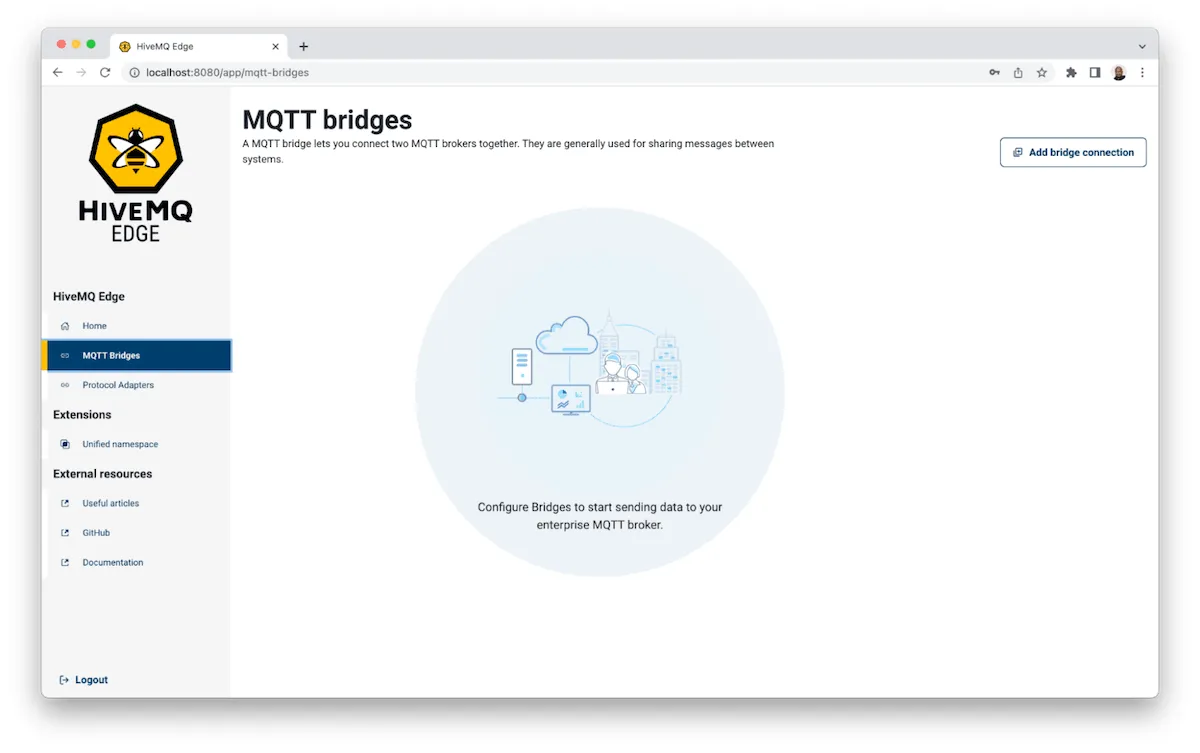
To establish an MQTT bridge connection, click on ‘Add bridge connection’, and then provide a unique name for your bridge and your cloud-based MQTT broker’s connection details. For this guide, we’ll use HiveMQ Cloud instance connection details. You will then need to indicate which MQTT topics from the local HiveMQ Edge broker you want to forward to the remote MQTT broker. For this demonstration, even though only one MQTT topic is being published locally, we’ll use the # wildcard to forward data on every topic.
You will then need to indicate which MQTT topics from the local HiveMQ Edge broker you want to forward to the remote MQTT broker. For this demonstration, even though only one MQTT topic is being published locally, we’ll use the # wildcard to forward data on every topic.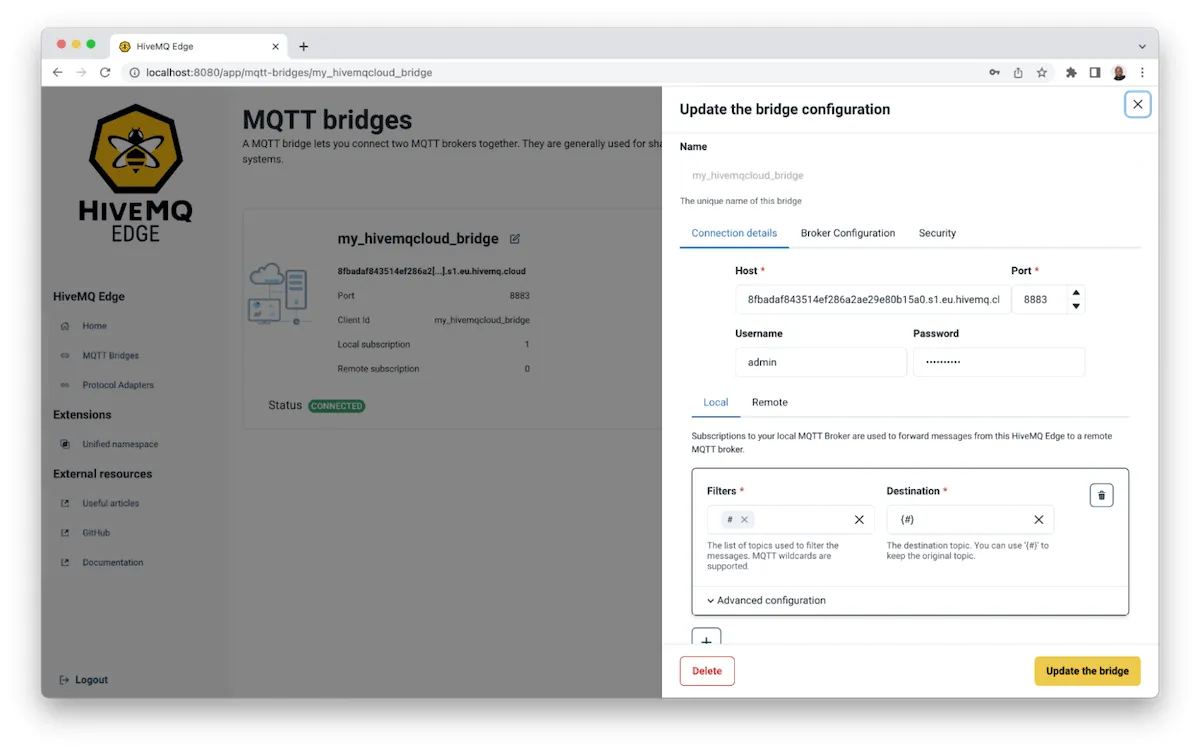 In the ‘Broker Configuration’ tab, enter additional details needed for connecting to your remote MQTT broker.
In the ‘Broker Configuration’ tab, enter additional details needed for connecting to your remote MQTT broker.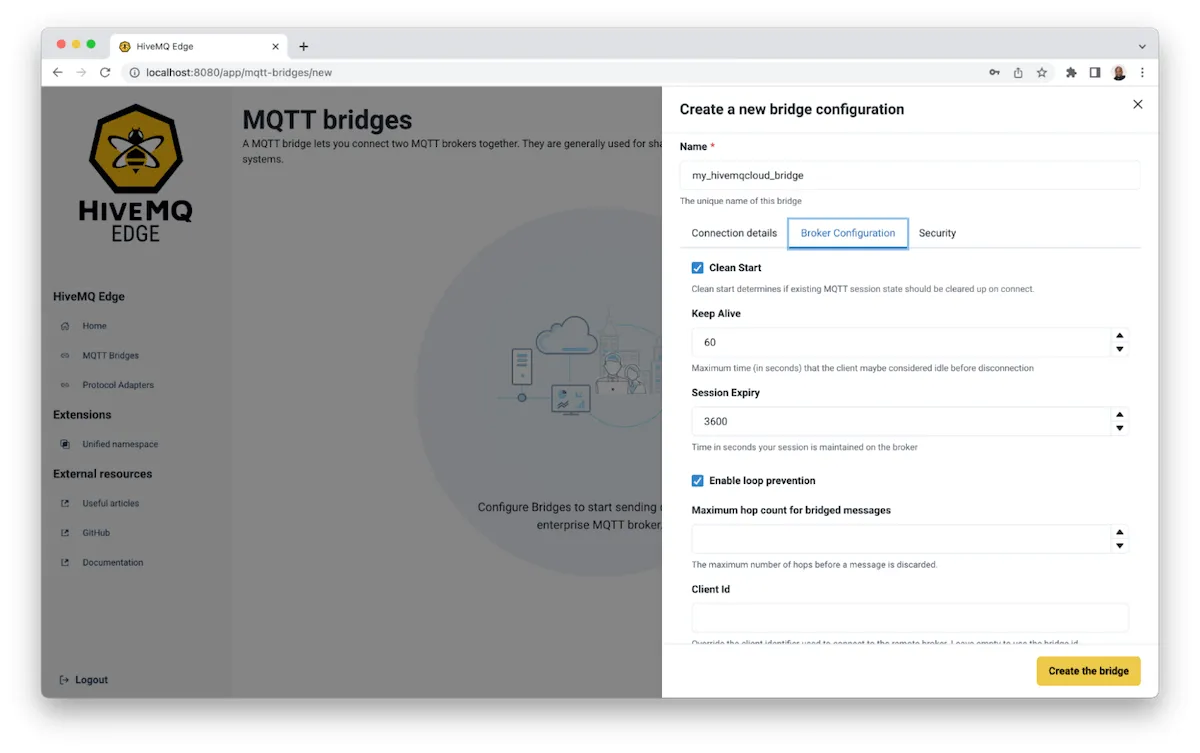 Next, under the ‘Security’ tab, you can opt to activate Transport Layer Security, as shown in this example and provide further security details if necessary.
Next, under the ‘Security’ tab, you can opt to activate Transport Layer Security, as shown in this example and provide further security details if necessary.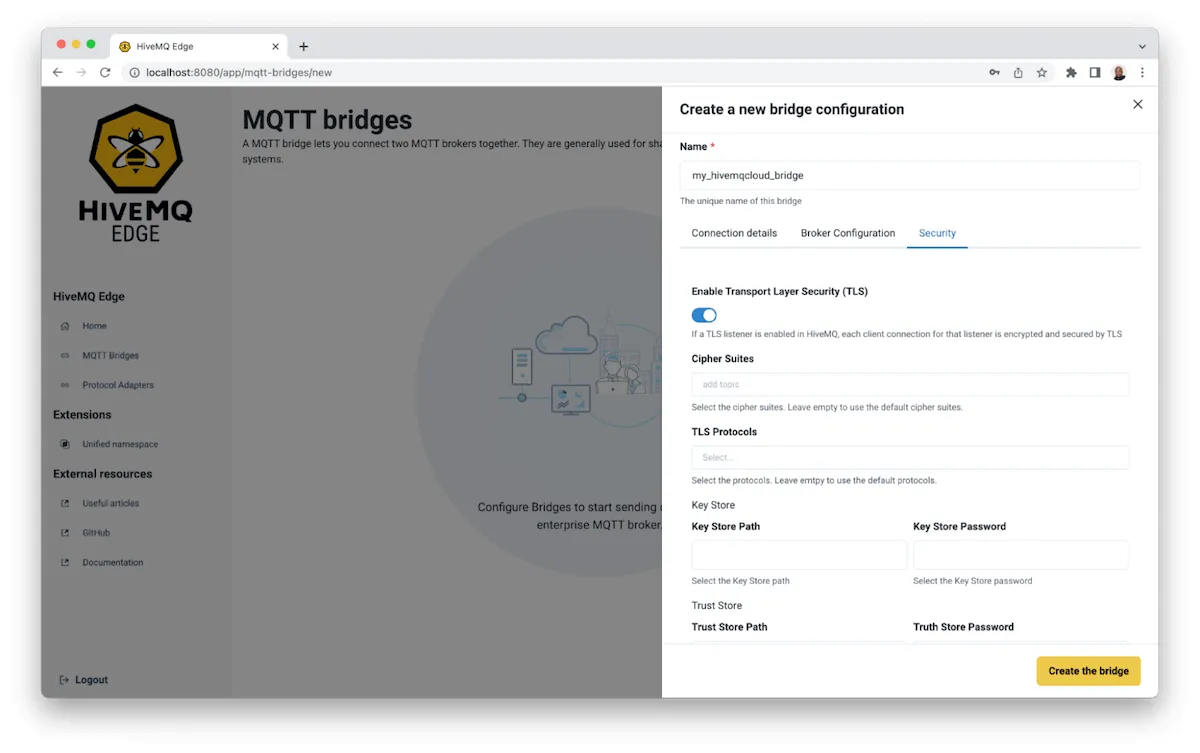 Once all required details are entered, select ‘Create the bridge’. A ‘Connected’ status should appear on your bridge configuration, indicating a successful setup.
Once all required details are entered, select ‘Create the bridge’. A ‘Connected’ status should appear on your bridge configuration, indicating a successful setup.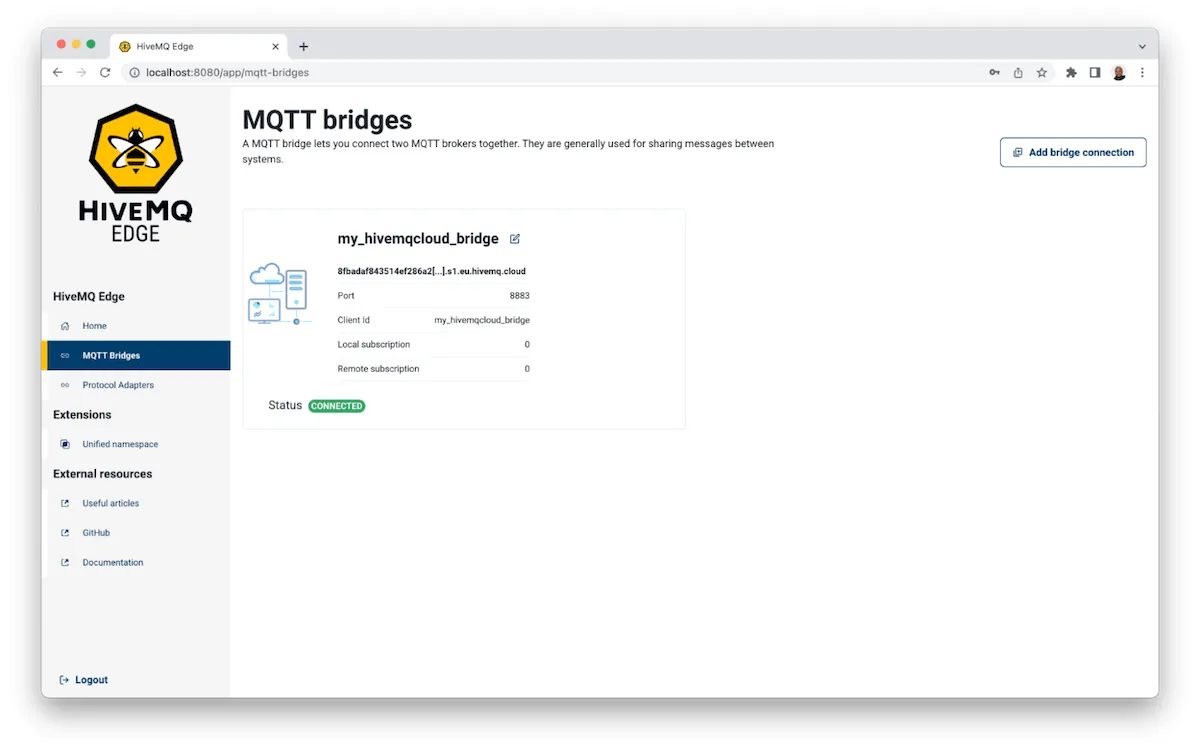 You have now successfully integrated data from an OPC UA Server to a cloud-based MQTT broker using HiveMQ Edge.
You have now successfully integrated data from an OPC UA Server to a cloud-based MQTT broker using HiveMQ Edge.
By choosing ‘Unified Namespace’ from the sidebar, you will be presented with an option to enable the Unified Namespace. Here, you can use the provided fields to publish your HiveMQ Edge data to an MQTT topic namespace that follows the semantic representation of your organizational hierarchy, based on the ISA 95 asset model.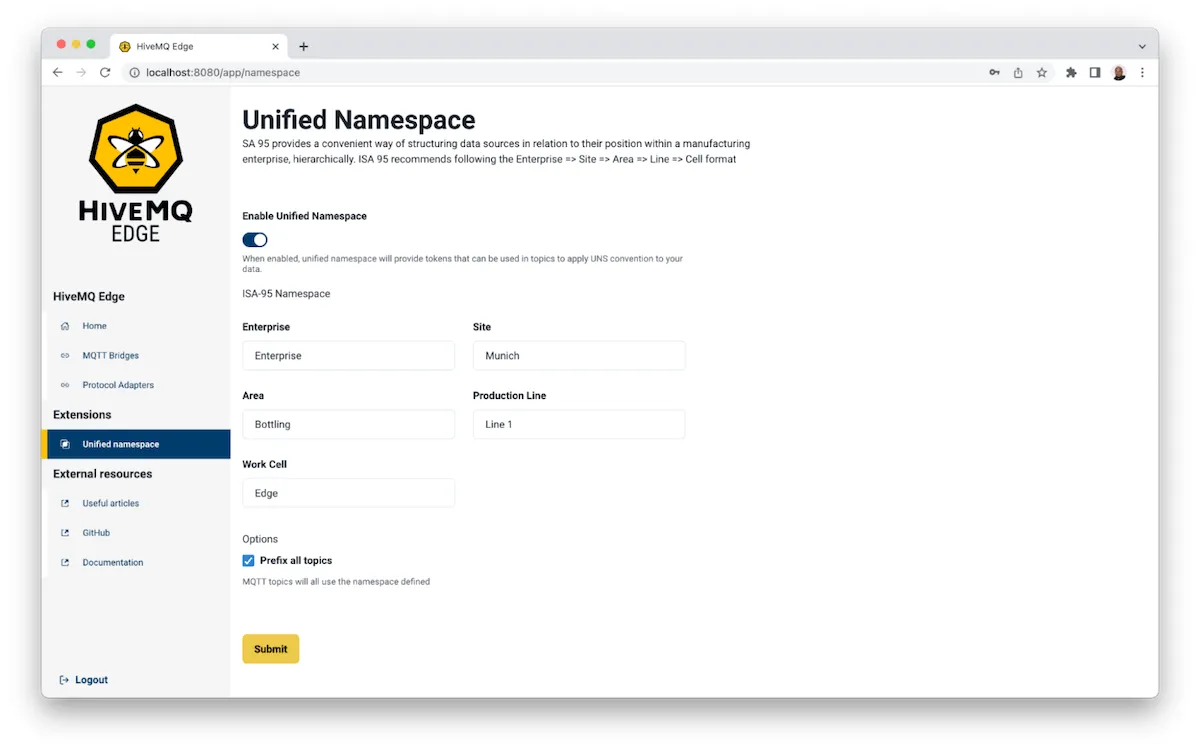 To verify if your data pipeline is functioning correctly, you can use an MQTT Client tool like HiveMQ Cloud Web Client to visualize the data from your OPC-UA server.
To verify if your data pipeline is functioning correctly, you can use an MQTT Client tool like HiveMQ Cloud Web Client to visualize the data from your OPC-UA server.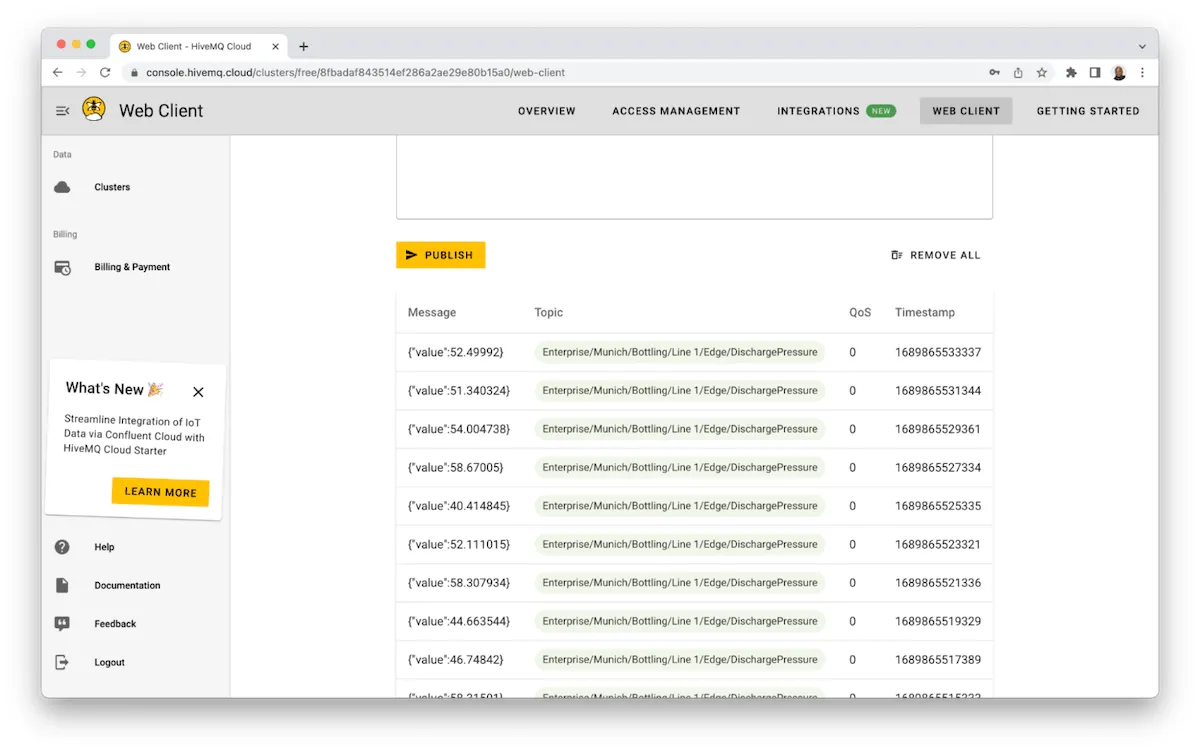
Get Started with HiveMQ Edge
Ready to start connecting to your industrial devices and sending streams of data to enterprise systems with HiveMQ Edge? Head over to our Github repo now to learn more and download the software gateway. HiveMQ is deeply involved in the space, and we’ll constantly be adding support for new protocols and functionality on the gateway.
We’re excited about the potential of HiveMQ Edge to help manufacturers modernize their IIoT infrastructure, and we hope you are too. We look forward to hearing about how HiveMQ Edge has made a difference in your digital transformation efforts, let us know in the HiveMQ Community Forum.
Additionaly, watch this webinar, Eliminating Data Silos with MQTT at the Edge, to learn how you can eliminate data silos and unify IIoT data to enable Unified Namespace, and feed key use cases.

Kudzai Manditereza
Kudzai is a tech influencer and electronic engineer based in Germany. As a Sr. Industry Solutions Advocate at HiveMQ, he helps developers and architects adopt MQTT, Unified Namespace (UNS), IIoT solutions, and HiveMQ for their IIoT projects. Kudzai runs a popular YouTube channel focused on IIoT and Smart Manufacturing technologies and he has been recognized as one of the Top 100 global influencers talking about Industry 4.0 online.
